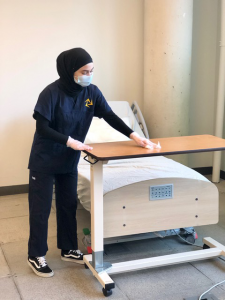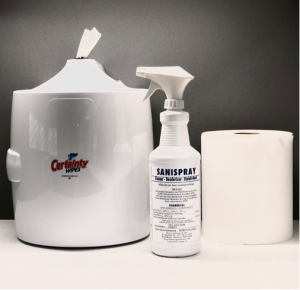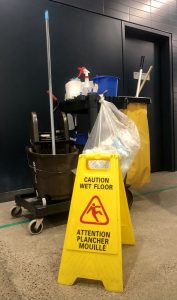Introduction to Environmental Hygiene
Environmental hygiene is maintaining a clean environment by cleaning equipment between use, disinfecting surfaces, and sterilizing medical equipment according to best practice to remove and destroy potential infectious microorganisms. Healthcare environments can harbour infectious microorganisms that have the potential to spread throughout the healthcare setting and infect susceptible individuals. Keeping the healthcare environment clean, including the client’s room, common areas, and workstations will break the chain of transmission and help decrease the risk of infection.
Following Public Health Ontario (2018) Best Practices for Environmental Cleaning for Prevention and Control of Infection in All Health Care Settings (3rd ed.) guidelines is essential to control the risk of transmission and maintain a safe hygienic environment. Best practice examples include cleaning and disinfecting the environment and equipment between client care (e.g., stethoscope, blood pressure cuff), designating equipment to additional-precaution isolation rooms, disposing of contaminated and soiled linen appropriately, changing linens often, placing sharps in designated containers, and terminal cleaning of rooms. Cleaning and disinfecting products in the healthcare setting must be approved by the infection prevention and control (IPAC) team and occupational health; and should be used according to manufacturer’s recommendations (Provincial Infectious Diseases Advisory Committee [PIDAC], 2018).
Cleaning and Disinfecting Environmental Surfaces
Healthcare settings have multiple people continuously coming in and out of the environment. Each of these individuals can potentially introduce new microorganisms into the environment. They may bring in infectious microorganisms, or visit infectious clients, or touch contaminated surfaces. The continuous movement of people within the healthcare setting, and their continuous interactions with the environment, increases the risk of transmission of infectious agents.

One way to decrease the transmission of infectious agents is effective cleaning and disinfecting of the healthcare environments (e.g., table surfaces, client’s personal items, medical equipment). Routine cleaning and disinfecting practices can help to reduce the transmission of microorganisms and decrease the risk of healthcare-associated infections (HAIs). It is essential for healthcare providers to understand the various risks of transmission, the required cleaning, disinfection, or sterilization needed according to the setting, and the cleaning products to use according to agency policies.
Before cleaning any surface, you need to determine what type of cleaning agent and disinfectant is compatible with the equipment. Familiarize yourself with your institutional policies and check manufacturer instructions (e.g., dilution rates, contact time, frequency, compatibility, safety considerations) if unsure. Identify and label any damaged equipment, and report it to the proper department (e.g., environmental services manager, occupational health department). All equipment should come with the manufacturer’s instructions for assembling/disassembling and cleaning (e.g., mechanical lifts, hospital beds, wheelchairs). Cleaning agents and disinfectants required for medical equipment or surfaces should be readily available and approved for use at the healthcare setting according to the infection prevention and control guidelines.
Cleaning Agents
Cleaning refers to the physical removal and reduction of foreign (e.g., dust, soil, grease, oils) and organic (e.g., blood, body secretion, microorganisms) materials from a surface through the use of mechanical action, water, and detergents (PIDAC, 2018). Cleaning can be a one-step (e.g., soap and water) or two-step (e.g., bleach [sodium hypochlorite] and hydrogen peroxide cleaner disinfectant wipes) process depending on the surface, type of microorganism, and amount of contamination. The physical movement of friction is key when cleaning a surface area.
Disinfectants
Disinfecting refers to the process of deactivating and killing most microorganisms through the use of disinfectants (PIDAC, 2018). There is no one disinfectant solution that will work for every microorganism and in every setting. Products that contain disinfectants must include a drug identification number or DIN, which is regulated by Health Canada (PIDAC, 2018). Examples of disinfectants include alcohol, hydrogen peroxide, bleach, iodophors, phenolics, and quaternary ammonium.
Cleaning techniques to avoid cross-contamination include:
- Remove visible soil before disinfecting an area.
- Clean high to low points.

- Clean dirty to dirtiest.
- Spray the cleaner or disinfectant solution on a clean cloth rather than directly on the surface.
- Change the side of the cloth or wipe before wiping a different surface of the item you are cleaning.
- Wipes or clothes need to stay wet when cleaning. Change wipes or spray more cleaning disinfectant on the cloth when it begins to dry.
Clinical Tip
Certain microorganisms require special cleaning protocols. For example, C. difficile, VRE, and MRSA can live on surfaces for extended periods of time and need to be eliminated to avoid transmission of the infectious agent. When these microorganisms are not eliminated from surfaces there is an increased risk of healthcare-associated infection transmissions.
Points of Consideration: Cleaning Agents and Disinfectants
 When using cleaning agents and disinfectants, follow healthcare setting guidelines to ensure client and environmental safety considerations. It is important to use the right product on the equipment or surface, allow the solution to sit and dry according to product guidelines, and always follow the manufacturer’s instructions. If cleaning products are not used correctly, they can harm the client and the healthcare provider. For example, you cannot combine some cleaning solutions (e.g., bleach and ammonia = toxic gas) and with other solutions you must wear with gloves to protect the skin integrity of your hands (e.g., disinfectant wipes). Be safe and follow the manufacturer guidelines.
When using cleaning agents and disinfectants, follow healthcare setting guidelines to ensure client and environmental safety considerations. It is important to use the right product on the equipment or surface, allow the solution to sit and dry according to product guidelines, and always follow the manufacturer’s instructions. If cleaning products are not used correctly, they can harm the client and the healthcare provider. For example, you cannot combine some cleaning solutions (e.g., bleach and ammonia = toxic gas) and with other solutions you must wear with gloves to protect the skin integrity of your hands (e.g., disinfectant wipes). Be safe and follow the manufacturer guidelines.
Attribution
This page was remixed with our own original content and adapted from:
Clinical Procedures for Safer Patient Care — Thompson Rivers University Edition by Renée Anderson, Glynda Rees Doyle, and Jodie Anita McCutcheon is used under a CC BY 4.0 Licence. This book is an adaptation of Clinical Procedures of Safer Patient Care by Glynda Rees Doyle and Jodie Anita McCutcheon, which is under a CC BY 4.0 Licence. A full list of changes and additions made by Renée Anderson can be found in the About the Book section.

